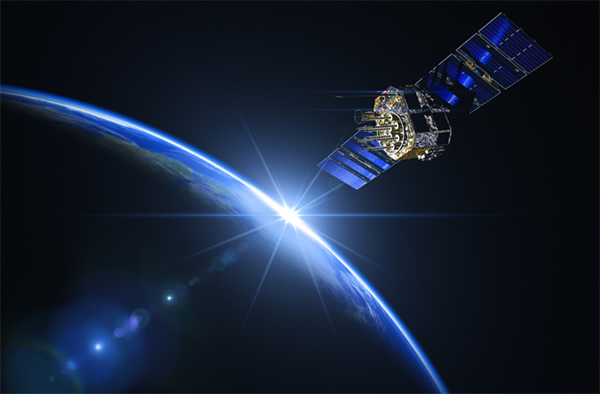Is Earth Surrounded by Dark Matter?
Artist's impression of a GPS satellite orbiting Earth. Have GPS systems detected the presence of a dark matter halo around our planet?
Dark mater: The stuff that possesses mass, yet refuses to interact with radiation, so we can't 'see' it. Its nature has eluded scientists for decades, but there could be a reservoir of the stuff sitting right on our doorstep — if the weird measurements made by Global Positioning System (GPS) satellites are proven to be caused by a halo of the so-called non-baryonic matter around our planet.
During a presentation at the American Geophysical Union (AGU) conference in San Francisco in December, GPS expert Ben Harris (of the University of Texas at Arlington) described some tricky measurements of the Earth’s mass using the armada of GPS satellites that are in orbit around our planet. He noticed a mass discrepancy when compared with “official” mass measurements as quoted by the International Astronomical Union (IAU).
“The nice thing about GPS satellites is that we know their orbits really, really well,” said Harris. This orbital knowledge helped Harris calculate the Earth’s vital statistic to a very high degree of precision. After analyzing 9 months of data from the GLONASS, GPS and Galileo satellite systems, he found that his measurement of Earth’s mass came in at between 0.005 and 0.008 percent larger than the IAU measurement.
What does this mean? Well, it could indicate some unforeseen error in data collection or analysis (in the GPS or IAU measurements), but there is another more intriguing possibility.
This mass discrepancy could be the influence of a halo, or ring, of dark matter surrounding Earth. By Harris’ reckoning, to explain his measurements, the invisible planetary dark matter halo would need to straddle the equator and be 191 kilometers (119 miles) thick by 70,000 kilometers (43,500 miles) wide.
As noted by New Scientist’s Anil Ananthaswamy, Harris has yet to factor in the effects of relativity and gravitational interactions with the sun and moon.
This research highlights the gaps in our knowledge dark matter. Non-baryonic matter is believed to account for 85 percent of all matter in the universe, but we have yet to directly observe this elusive form of matter, let alone create it in immense particle accelerators like the Large Hadron Collider. We know it’s out there, however, bulking-out galactic clusters and warping spacetime. Through indirect means, such as gravitational lensing and orbital motions, we can detect the stuff and this most recent GPS measurements provide another tantalizing means of understanding the subtle mass effects on a potential Earth-dark matter coupling.
Interestingly, the hypothetical presence of dark matter could have another subtle effect on our planetary neighborhood. During measurements of spacecraft flybys of Earth, very slight anomalies in spacecraft speed have been detected. For example, NASA’s NEAR asteroid spacecraft used our planet for a gravitational speed assist in January 1998. During the flyby, in addition to the extra velocity the flyby provided, there was an additional mystery boost of 13 millimeters/second. This tiny boost, which has been spotted in other spacecraft flybys, is known as a “flyby anomaly,” and one of the contributing factors could be the gravity exerted on the spacecraft by an invisible halo of dark matter.
The most recent flyby, however, of NASA’s Juno Jupiter mission in November, has yet to revel any velocity anomaly, only adding to the mysterious nature of flyby anomalies.(Jan 3, 2014 02:29 PM ET // by Ian O'Neill)












